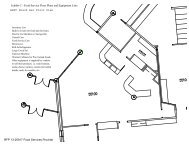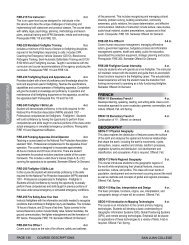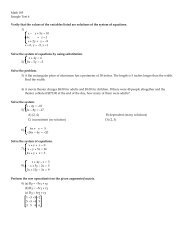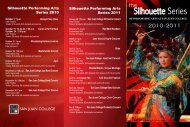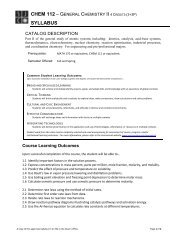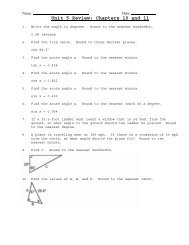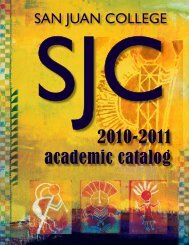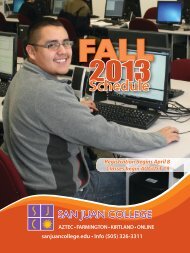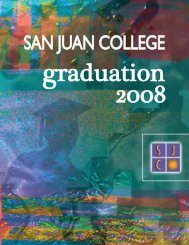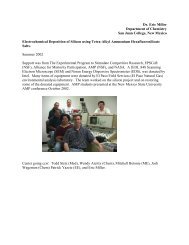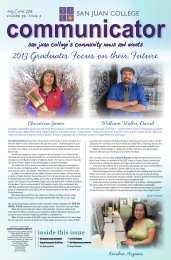AQIP 2007 Systems Portfolio - San Juan College
AQIP 2007 Systems Portfolio - San Juan College
AQIP 2007 Systems Portfolio - San Juan College
You also want an ePaper? Increase the reach of your titles
YUMPU automatically turns print PDFs into web optimized ePapers that Google loves.
<strong>San</strong> <strong>Juan</strong> <strong>College</strong> – <strong>AQIP</strong> <strong>Systems</strong> <strong>Portfolio</strong> – November <strong>2007</strong>• A summer 2003 workgroup, primarily faculty,drafted institutional learning outcomes.• Fall 2003, “Meeting of the Minds” attendees(faculty, deans, staff) made furtherrecommendations.• Faculty and staff from each school and theStudent Success Center researched andbenchmarked with other institutions to refineinstitutional learning outcomes.• With input from the Quality Student LearningCouncil (QLC) and fine tuning by school faculties,the five Common Student Learning Outcomes,a.k.a. CSLOs--Learn, Think, Communicate,Integrate, and Act--were approved by the QSLCand the President in January 2004.• By Fall 2004, CSLOs were included in all coursesyllabi to demonstrate the institutionalcommitment to them.In 2006 the Quality Student Support Council (QSSC)was tasked to develop a model for assessing studentlearning (SSLOs) in Student Services departmentswith the purpose of: (1) improving utilization of timeand resources, (2) communicating the value ofstudent services work for student learning and (3)increasing collaboration between Learning andStudent ServicesA sub-committee from QSSC researched Council forthe Advancement of Standards in Higher Education(CAS) standards and dialogued with the StudentOutcomes Assessment Committee. Two members ofthe QSSC and the Vice President for InstitutionalResearch & Planning benchmarked student servicesassessment practices at the Community <strong>College</strong> ofBaltimore County and Harford Community <strong>College</strong>.In addition, many SJC programs are designed to meetexternal accreditation standards which often haveadditional skill-specific learning objectives (Table 1.8).1P2 New courses and programs are designed as aresult of requests from the local community, localindustries and businesses, students and evidence ofnational trends. The process calls for a thoroughanalysis of need, financial aid needs, advising needs,faculty expertise, and facilities needs. The process isas described in 1P8 (Figure 1.1).Recent examples of programs in which this has beenused are School of Health Science programsincluding Medical Laboratory Technology, SurgicalTechnology Respiratory Technology and EmergencyMedical Services programs.NursingVeterinary TechnologyDental HygieneAlternative Licensure inElementary, Secondary andSpecial EducationPhysical Therapist AssistantBusiness AdministrationAutomotive TechnologySJC Program AccreditationsTable1. 8: SJC Program AccreditationsNational League for Nursing,Accrediting Commission,New Mexico Board of NursingAmerican Veterinary MedicalAssociationCommission on DentalAccreditation of the AmericanDental AssociationNew Mexico Public EducationDepartmentCommission on Accreditationin Physical Therapy EducationAssociation of CollegiateBusiness Schools andProgramsNational AutomotiveTechnology EducationFoundation1P3 SJC determines the preparation required ofstudents for the specific programs they will pursuebased upon stated program requirements. All <strong>San</strong><strong>Juan</strong> <strong>College</strong> courses have clearly stated learningoutcomes and objectives. From these objectives andoutcomes, faculty members have determined theminimum skill level required of entering students andthus, the pre-requisite courses and requiredplacement test scores. When <strong>San</strong> <strong>Juan</strong> <strong>College</strong>developed its mandatory placement policy, a facultycommittee outlined the curriculum covered in theMathematics, English, and Reading courses, bothdevelopmental and college level courses, to helpinstructors determine which courses covered the skilllevels they required of their students. These matriceswere then used to set pre-requisites for coursesacross campus. In the fall of 2006, <strong>San</strong> <strong>Juan</strong> <strong>College</strong>committed to mandatory placement for Mathematics,English and Reading. A faculty committee reviewedand determined the Accuplacer placement test cutoff scores. All incoming degree seeking students,taking more than six credits, are required to take theAccuplacer exam. If they test below certain cut-offscores, students are required to begin withdevelopmental courses in the disciplines for whichdevelopmental prerequisites have been established.The use of charrettes is becoming part of <strong>San</strong> <strong>Juan</strong>’sprocess for aligning its curricula with student needsand public expectations of the outcomes of a collegeeducation. Due to continuing concerns, both at the<strong>College</strong> and statewide, regarding the progress of<strong>AQIP</strong> Category One: Helping Students Learn 5



